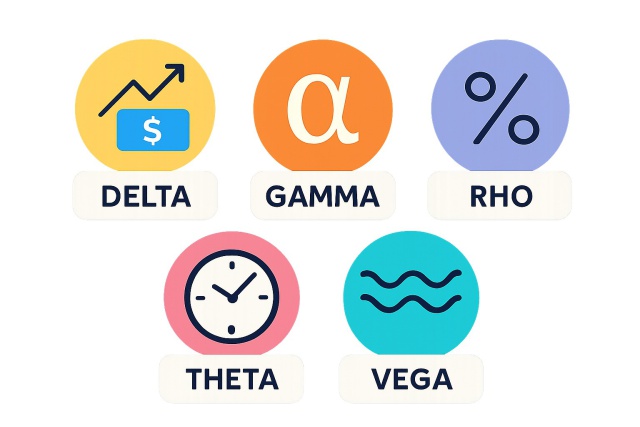
Option Trading Greeks Explained for Beginners
Demystify option trading Greeks with our simple guide. Learn how Delta, Gamma, Theta, Vega, and Rho...

Delta neutral options trading is a clever strategy that many traders lean on to keep risk in check by minimizing their exposure to price swings in the underlying asset. Essentially, it means setting up positions so that the total delta—which is just a fancy way of saying how sensitive your position is to price changes—is hovering near zero. By doing this, traders sidestep the usual rollercoaster of price bets and instead zero in on earning profits from things like time decay and volatility shifts. It’s a neat trick for keeping portfolios tucked away from sudden market whipsaws while aiming for smoother, more consistent returns.
Options derive their value from the price of an underlying asset plain and simple. Delta, one of the key Greeks, tells you how much the option's price will wiggle when the underlying asset moves one point.
Delta measures how much an option’s price tends to wiggle when the price of its underlying asset takes a $1 stroll. It swings between -1 and 1, with positive values usually flagging call options and negative values pointing toward puts.
Traders often hunt for delta neutral positions as a way to shield themselves from price swings going either way. This clever strategy lets them zero in on gains from things like time decay and shifts in implied volatility.
Delta neutral options trading is all about carefully balancing positive and negative delta positions so that the net delta hovers close to zero.
Common delta neutral strategies often revolve around market-neutral spreads such as calendar spreads and iron condors. These blends of long and short options keep delta values balanced. Option straddles and strangles also aim for delta neutrality by purchasing calls and puts at or near the same strike price or expiration date—kind of like hedging your bets from both sides.
| Strategy Name | Description | Typical Setup | Pros | Cons |
|---|---|---|---|---|
| Calendar Spread | Buying and selling options with the same strike but different expiration dates | Long near-term option, short longer-term option | Benefits from time decay and usually needs less capital than you would expect | Demands pretty precise timing and can feel the heat from volatility swings |
| Iron Condor | Selling out-of-the-money call and put spreads at the same time | Sell OTM call & put, buy further OTM call & put | Offers limited risk and reward, making it a good fit for those flat, sideways markets | Profit potential is capped, and adjusting the position can get fiddly |
| Straddle | Buying both a call and a put at the same strike and expiration | Buy call and put at ATM strike | Can cash in on big moves either way, up or down, which is pretty handy | Premiums tend to be on the pricey side and it quickly loses value if the price just chills |
| Delta Hedging | Holding shares of the underlying asset to balance option delta | Hold options and buy/sell shares proportional to delta | Helps keep you in a neutral spot as the market dances around | Requires frequent rebalancing and can add up in commission fees |

Visual representation of delta neutral trading strategies showing how combined positions balance delta.
Start off by figuring out your risk tolerance and setting clear trading goals. This way you get a solid understanding of how much exposure you can comfortably handle without losing sleep.
Choose an underlying asset and carefully review its option chain to see available strikes and expiration dates. Think of it like browsing a menu before making your order.
Calculate the delta for each option you are considering. Then crunch the numbers to find the net delta of the position you are planning. It might require some homework but it is definitely worth the effort.
Create a mix of options or underlying shares that brings your net delta as close to zero as possible. Your goal is to hit the ideal spot known as delta neutrality.
Keep a close watch on your position because price swings, volatility changes and time decay can quickly disrupt your delta neutrality.
Remember to use risk management tools such as stop-loss orders and position limits. These act as safety nets to prevent unpleasant surprises from turning into big losses.
You can figure out your net delta by multiplying each option's delta by the number of contracts you hold, then adding up those results across all your positions.
Delta values are always on the move, shifting with every twist and turn in the underlying price and the inevitable march of time decay. If traders want to keep their positions delta neutral, they’ve got to keep a sharp eye on these fluctuations and be ready to tweak their holdings regularly
Ongoing risk management is absolutely vital for keeping the position nicely balanced as market conditions do their usual dance. Without those careful tweaks, even the smallest shifts in delta can sneakily expose the portfolio to directional risk.
"Keeping discipline by making timely adjustments in delta neutral portfolios usually does the trick to keep performance steady, especially when the market decides to throw a tantrum. Patience and accuracy aren’t just nice-to-haves here—they're the secret sauce for juggling these ever-changing positions without breaking a sweat." – Experienced Options Trader
Delta neutral trading comes with its fair share of headaches like shelling out high transaction costs due to constant rebalancing. Then there’s slippage during wild volatile market swings. Liquidity isn’t always a walk in the park either, especially for some options, and this can put a real crimp in your plans. Do not forget the tricky business of pinning down delta accurately because the market keeps throwing curveballs.
Sticking to a disciplined approach is absolutely vital when it comes to delta neutral strategies. I have found that resisting the urge to react emotionally to every little blip in the market noise can save you quite a bit of headache. Setting clear-cut rules for when to tweak your positions—grounded firmly in solid data rather than wild guesses—usually pays off in the long run.
Navigating the world of delta neutral trading can seem like trying to juggle flaming torches—tricky but rewarding if you get the hang of it. Here, we will dive into the essential practices and handy tips that'll help you keep your positions balanced and your strategy sharp. Whether you are a seasoned pro or just dipping your toes in, these insights aim to make the complex a little more approachable and maybe even a bit enjoyable.
Mastering delta neutral options trading requires a good deal of patience and a calm, steady approach to learning. It’s wise to start off cautiously, picking up experience little by little rather than rushing in headfirst. Tapping into online communities or leaning on educational resources can really help you stay in the loop with the latest strategies.
Struggling to improve your trading performance? Edgewonk's advanced analytics tools are designed to give you the edge you need.
With detailed trade journaling, robust strategy analysis, and psychological insights, you'll gain a comprehensive understanding of your strengths and weaknesses. Don't miss out on this game-changing opportunity.
Traders, it's time to elevate your game. Edgewonk is the ultimate trading journal software designed to empower you with data-driven insights and personalized strategies. Take control of your trading journey and maximize your potential.
11 articles published
Driven by a passion for democratizing financial markets, he creates accessible trading education content that bridges the gap between complex strategies and retail investors.
Read Posts
Demystify option trading Greeks with our simple guide. Learn how Delta, Gamma, Theta, Vega, and Rho...

Explore how commodities options trading offers beginners a flexible way to invest in gold, oil, and...

Unlock the power of options chain analysis with TrendSpider’s automated and visual tools to make sma...

Master day trading options with practical strategies, essential risk management, and step-by-step in...
